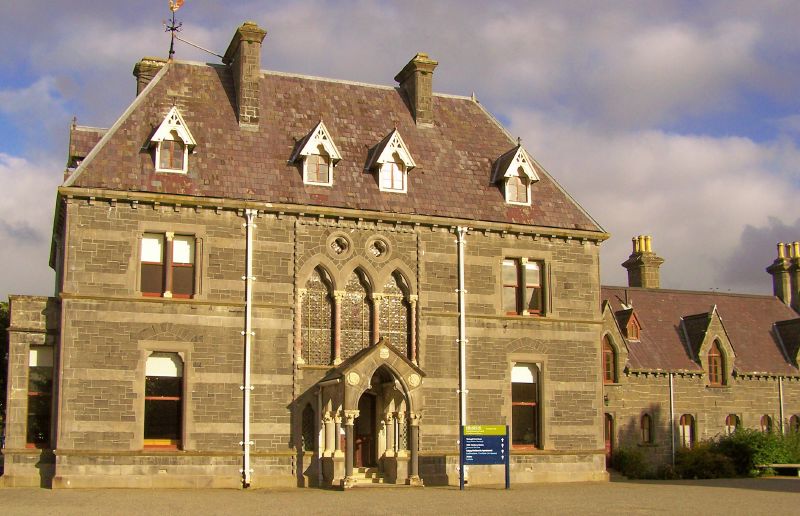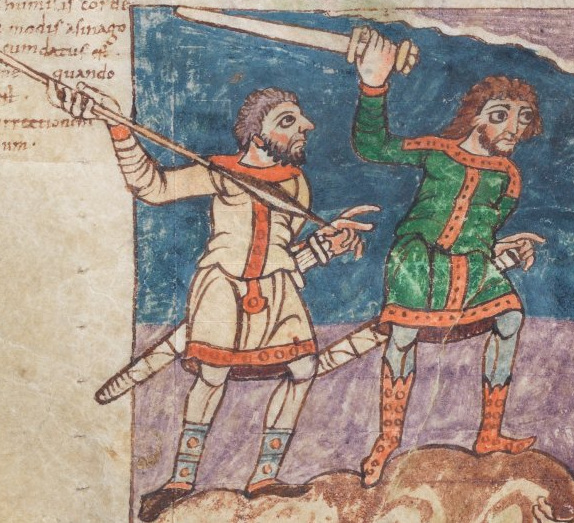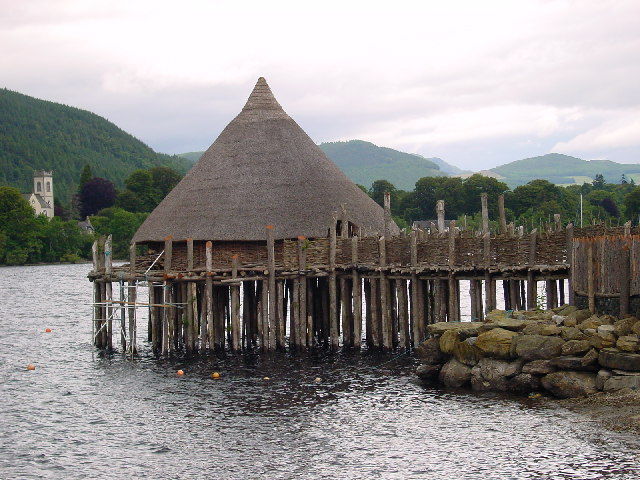|
Ballinderry Sword
The Ballinderry Sword is an iron Viking-style weapon found in a bog on the site of a crannog (lake dwelling) in Ballinderry, in Rosemount, County Westmeath, Ireland in 1928. It is No. 36 in '' A History of Ireland in 100 Objects''.O'Toole, F. (2011) '' A History of Ireland in 100 Objects''''Irish Times'' (Accessed: 11 July 2016). It was found along with other Viking objects: a longbow, two spearheads, an axe head and a gaming board. The settlement dates from between the late 9th and early 11th centuries, and the collection of artifacts uncovered appears to fit the profile of a wealthy Irish farmer or of a local ruler. The sword's pommel is coated in a sheet of silver and consists of five distinct sections that slowly rise to a rounded tip in the middle. Below these sections is a band of silver decorated with a recessed pattern of swirls that loop around the pommel. The hilt of the sword is also coated in silver and bears the same swirl pattern as the band on the pommel. There ... [...More Info...] [...Related Items...] OR: [Wikipedia] [Google] [Baidu] |
Viking
Vikings ; non, víkingr is the modern name given to seafaring people originally from Scandinavia (present-day Denmark, Norway and Sweden), who from the late 8th to the late 11th centuries raided, pirated, traded and settled throughout parts of Europe.Roesdahl, pp. 9–22. They also voyaged as far as the Mediterranean Sea, Mediterranean, North Africa, Volga Bulgaria, the Middle East, and Greenland, North America. In some of the countries they raided and settled in, this period is popularly known as the Viking Age, and the term "Viking" also commonly includes the inhabitants of the Scandinavian homelands as a collective whole. The Vikings had a profound impact on the Early Middle Ages, early medieval history of Scandinavia, the History of the British Isles, British Isles, France in the Middle Ages, France, Viking Age in Estonia, Estonia, and Kievan Rus'. Expert sailors and navigators aboard their characteristic longships, Vikings established Norse settlem ... [...More Info...] [...Related Items...] OR: [Wikipedia] [Google] [Baidu] |
National Museum Of Ireland
The National Museum of Ireland ( ga, Ard-Mhúsaem na hÉireann) is Ireland's leading museum institution, with a strong emphasis on national and some international archaeology, Irish history, Irish art, culture, and natural history. It has three branches in Dublin, the archaeology and natural history museums adjacent on Kildare Street and Merrion Square, and a newer Decorative Arts and History branch at the former Collins Barracks, and the Country Life museum in County Mayo. History Predecessors The National Museum of Ireland descends from the amalgamation of parts of the collections of a number of Dublin cultural institutions from the 18th and 19th centuries, including primarily the Royal Dublin Society (RDS) and the Royal Irish Academy (RIA). The earliest parts of the collections are largely geological and mineralogical specimens, which the RDS collected as a means to improve the knowledge and use of such resources in Ireland. The establishment of the museum collections ... [...More Info...] [...Related Items...] OR: [Wikipedia] [Google] [Baidu] |
Collection Of The National Museum Of Ireland
Collection or Collections may refer to: * Cash collection, the function of an accounts receivable department * Collection (church), money donated by the congregation during a church service * Collection agency, agency to collect cash * Collections management (museum) ** Collection (museum), objects in a particular field forms the core basis for the museum ** Fonds in archives ** Private collection, sometimes just called "collection" * Collection (Oxford colleges), a beginning-of-term exam or Principal's Collections * Collection (horse), a horse carrying more weight on his hindquarters than his forehand * Collection (racehorse), an Irish-bred, Hong Kong based Thoroughbred racehorse * Collection (publishing), a gathering of books under the same title at the same publisher * Scientific collection, any systematic collection of objects for scientific study Collection may also refer to: Computing * Collection (abstract data type), the abstract concept of collections in compute ... [...More Info...] [...Related Items...] OR: [Wikipedia] [Google] [Baidu] |
1928 In Ireland
Events from the year 1928 in Ireland. Incumbents * Governor-General: ** Tim Healy (until 31 January) ** James McNeill (from 31 January) * President of the Executive Council: W. T. Cosgrave ( CnaG) Events *29 January – in Belfast, members of the nationalist opposition protest at the Ulster Unionist Party government's plan to abolish Proportional representation. *31 January – the outgoing Governor-General, T. M. Healy leaves the Vice-Regal Lodge. His successor is James McNeill. *25 February – William O'Brien, former activist in the Home Rule and land campaigns, dies in London aged 75. *12 April – the first east–west transatlantic flight by aeroplane leaves Baldonnel Aerodrome in Dublin. Commandant James Fitzmaurice is on board the '' Bremen''. *30 April – cheering crowds in New York greet the crew of the ''Bremen'' after it has made its transatlantic flight. *19 May – the foundation stone of the new Northern Ireland Parliament Building is laid at Stormont. * ... [...More Info...] [...Related Items...] OR: [Wikipedia] [Google] [Baidu] |
Viking Swords
The Viking Age sword (also Viking sword) or Carolingian sword is the type of sword prevalent in Western and Northern Europe during the Early Middle Ages. The Viking Age or Carolingian-era sword developed in the 8th century from the Merovingian sword more specifically, the Frankish production of swords in the 6th to 7th century and during the 11th to 12th century in turn gave rise to the knightly sword of the Romanesque period. Terminology Although popularly called "Viking sword", this type of sword was produced in the Frankish Empire during the Carolingian era. The association of the name "Viking" with these swords is due to the disappearance of grave goods in Christian Francia in the 8th century, due to which the bulk of sword blades of Frankish manufacture of this period were found in pagan burials of Viking Age Scandinavia, imported by trade, ransom payment or looting, while continental European finds are mostly limited to stray finds in riverbeds. Swords of the 8th to 10th ... [...More Info...] [...Related Items...] OR: [Wikipedia] [Google] [Baidu] |
Medieval European Swords
In the history of Europe, the Middle Ages or medieval period lasted approximately from the late 5th to the late 15th centuries, similar to the Post-classical, post-classical period of World history (field), global history. It began with the fall of the Western Roman Empire and transitioned into the Renaissance and the Age of Discovery. The Middle Ages is the middle period of the three traditional divisions of Western history: classical antiquity, the medieval period, and the modern history, modern period. The medieval period is itself subdivided into the Early Middle Ages, Early, High Middle Ages, High, and Late Middle Ages. Population decline, counterurbanisation, the collapse of centralized authority, invasions, and mass migrations of tribes, which had begun in late antiquity, continued into the Early Middle Ages. The large-scale movements of the Migration Period, including various Germanic peoples, formed new kingdoms in what remained of the Western Roman Empire. In the ... [...More Info...] [...Related Items...] OR: [Wikipedia] [Google] [Baidu] |
European Weapons
European, or Europeans, or Europeneans, may refer to: In general * ''European'', an adjective referring to something of, from, or related to Europe ** Ethnic groups in Europe ** Demographics of Europe ** European cuisine, the cuisines of Europe and other Western countries * ''European'', an adjective referring to something of, from, or related to the European Union ** Citizenship of the European Union ** Demographics of the European Union In publishing * ''The European'' (1953 magazine), a far-right cultural and political magazine published 1953–1959 * ''The European'' (newspaper), a British weekly newspaper published 1990–1998 * ''The European'' (2009 magazine), a German magazine first published in September 2009 *''The European Magazine'', a magazine published in London 1782–1826 *''The New European'', a British weekly pop-up newspaper first published in July 2016 Other uses * * Europeans (band), a British post-punk group, from Bristol See also * * * Europe (disambi ... [...More Info...] [...Related Items...] OR: [Wikipedia] [Google] [Baidu] |
European Swords
European, or Europeans, or Europeneans, may refer to: In general * ''European'', an adjective referring to something of, from, or related to Europe ** Ethnic groups in Europe ** Demographics of Europe ** European cuisine, the cuisines of Europe and other Western countries * ''European'', an adjective referring to something of, from, or related to the European Union ** Citizenship of the European Union ** Demographics of the European Union In publishing * ''The European'' (1953 magazine), a far-right cultural and political magazine published 1953–1959 * ''The European'' (newspaper), a British weekly newspaper published 1990–1998 * ''The European'' (2009 magazine), a German magazine first published in September 2009 *''The European Magazine'', a magazine published in London 1782–1826 *''The New European'', a British weekly pop-up newspaper first published in July 2016 Other uses * * Europeans (band), a British post-punk group, from Bristol See also * * * Europe (disambi ... [...More Info...] [...Related Items...] OR: [Wikipedia] [Google] [Baidu] |
Rhineland
The Rhineland (german: Rheinland; french: Rhénanie; nl, Rijnland; ksh, Rhingland; Latinised name: ''Rhenania'') is a loosely defined area of Western Germany along the Rhine, chiefly its middle section. Term Historically, the Rhinelands refers (physically speaking) to a loosely defined region embracing the land on the banks of the Rhine in Central Europe, which were settled by Ripuarian and Salian Franks and became part of Frankish Austrasia. In the High Middle Ages, numerous Imperial States along the river emerged from the former stem duchy of Lotharingia, without developing any common political or cultural identity. A "Rhineland" conceptualization can be traced to the period of the Holy Roman Empire from the sixteenth until the eighteenth centuries when the Empire's Imperial Estates (territories) were grouped into regional districts in charge of defence and judicial execution, known as Imperial Circles. Three of the ten circles through which the Rhine flowed referr ... [...More Info...] [...Related Items...] OR: [Wikipedia] [Google] [Baidu] |
Crannog
A crannog (; ga, crannóg ; gd, crannag ) is typically a partially or entirely artificial island, usually built in lakes and estuarine waters of Scotland, Wales, and Ireland. Unlike the prehistoric pile dwellings around the Alps, which were built on the shores and not inundated until later, crannogs were built in the water, thus forming artificial islands. Crannogs were used as dwellings over five millennia, from the European Neolithic Period to as late as the 17th/early 18th century. In Scotland there is no convincing evidence in the archaeological record of Early and Middle Bronze Age or Norse Period use. The radiocarbon dating obtained from key sites such as Oakbank and Redcastle indicates at a 95.4 per cent confidence level that they date to the Late Bronze Age to Early Iron Age. The date ranges fall ''after'' around 800 BC and so could be considered Late Bronze Age by only the narrowest of margins. Crannogs have been variously interpreted as free-standing wooden struct ... [...More Info...] [...Related Items...] OR: [Wikipedia] [Google] [Baidu] |
ULFBERHT
The Ulfberht swords are a group of about 170 medieval swords found primarily in Northern Europe, dated to the 9th to 11th centuries, with blades inlaid with the inscription ''+VLFBERH+T or +VLFBERHT+''. The word "Ulfberht" is a Frankish personal name, possibly indicating the origin of the blades. Description The swords are at the transitional point between the Viking sword and the high medieval knightly sword. Most have blades of Oakeshott type X. They are also the starting point of the much more varied high medieval tradition of blade inscriptions. The reverse sides of the blades are inlaid with a geometric pattern, usually a braid pattern between vertical strokes. Numerous blades also bear this type of geometric pattern but no ''Vlfberht'' inscription. Ulfberht swords were made during a period when European swords were still predominantly pattern welded ("false Damascus"), but with larger blooms of steel gradually becoming available, so that higher quality swords made af ... [...More Info...] [...Related Items...] OR: [Wikipedia] [Google] [Baidu] |
Swords In The National Museum Dublin
A sword is a cutting and/or thrusting weapon. Sword, Swords, or The Sword may also refer to: Places * Swords, Dublin, a large suburban town in the Irish capital * Swords, Georgia, a community in the United States * Sword Beach, code name for the Normandy Coast landing area on D-day in World War II Arts, media, and entertainment Film and television * Swords (TV series), ''Swords'' (TV series), a documentary TV series on the Discovery Channel * The Sword (1980 film), ''The Sword'' (1980 film), a 1980 film by Patrick Tam Kar-Ming * Ken (film), ''Ken'' (film), a 1964 Japanese film also known as "The Sword" * "The Sword", an List of G.I. Joe: A Real American Hero episodes#Season 2 (1991), episode of the DiC cartoon ''G.I. Joe: A Real American Hero'' Literature * S.W.O.R.D. (comics), a fictional counterterrorism and intelligence agency in Marvel Comics * S.W.O.R.D. (The Saint), a fictional criminal organization in the novel ''The Saint and the Fiction Makers'' * The Sword (magazine) ... [...More Info...] [...Related Items...] OR: [Wikipedia] [Google] [Baidu] |






